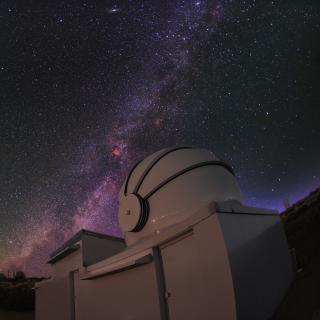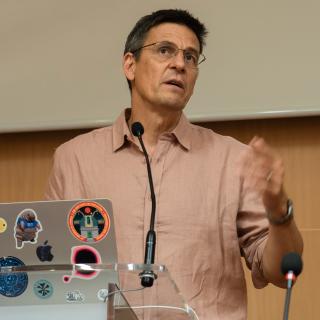It may interest you
-
 The third telescope of the Two-metre Twin Telescope (TTT3) situated in the Teide Observatory of the Instituto de Astrofísica de Canarias (IAC) has seen its “first light”. This robotic 2 meter telescope, managed by the Canary company Light Bridges, is one of the largest of its kind in the world.Advertised on
The third telescope of the Two-metre Twin Telescope (TTT3) situated in the Teide Observatory of the Instituto de Astrofísica de Canarias (IAC) has seen its “first light”. This robotic 2 meter telescope, managed by the Canary company Light Bridges, is one of the largest of its kind in the world.Advertised on -
 The Instituto de Astrofísica de Canarias (IAC) welcomed the visit of Professor Didier Queloz, Nobel Laureate in Physics and co-discoverer of the first exoplanet orbiting a Sun-like star. Professor Queloz's stay at the IAC has focused on instrumental development and technological collaboration. As part of his agenda, he also gave a lecture entitled ‘Exoplanets: the next frontier’ in the IAC Lecture Hall. The researcher visited the IAC to supervise the installation of a new high-stability spectrograph on the Isaac Newton Telescope (INT) at the Roque de los Muchachos Observatory on La PalmaAdvertised on
The Instituto de Astrofísica de Canarias (IAC) welcomed the visit of Professor Didier Queloz, Nobel Laureate in Physics and co-discoverer of the first exoplanet orbiting a Sun-like star. Professor Queloz's stay at the IAC has focused on instrumental development and technological collaboration. As part of his agenda, he also gave a lecture entitled ‘Exoplanets: the next frontier’ in the IAC Lecture Hall. The researcher visited the IAC to supervise the installation of a new high-stability spectrograph on the Isaac Newton Telescope (INT) at the Roque de los Muchachos Observatory on La PalmaAdvertised on -
 El Instituto de Astrofísica de Canarias (IAC) sigue afianzando su liderazgo investigador y de atracción de talento científico con el programa “ Investigadores Visitantes” de Fundación Occident. En este recién terminado año 2024, el programa cumple una década ininterrumpida de trabajo atrayendo a decenas de personas investigadoras cada año que han realizado estancias, de mínimo un mes y hasta tres meses, en el IAC. El programa permite que el personal investigador invitado comparta espacio y trabajo con miembros de los distintos grupos de investigación establecidos en el IAC, de forma que elAdvertised on
El Instituto de Astrofísica de Canarias (IAC) sigue afianzando su liderazgo investigador y de atracción de talento científico con el programa “ Investigadores Visitantes” de Fundación Occident. En este recién terminado año 2024, el programa cumple una década ininterrumpida de trabajo atrayendo a decenas de personas investigadoras cada año que han realizado estancias, de mínimo un mes y hasta tres meses, en el IAC. El programa permite que el personal investigador invitado comparta espacio y trabajo con miembros de los distintos grupos de investigación establecidos en el IAC, de forma que elAdvertised on